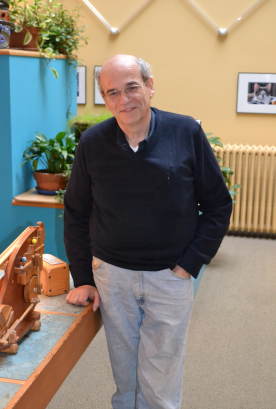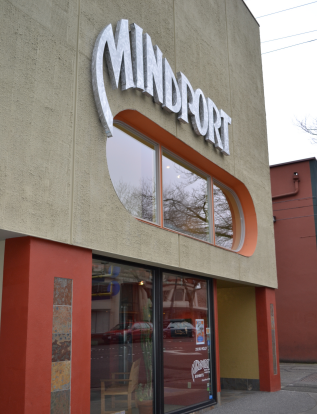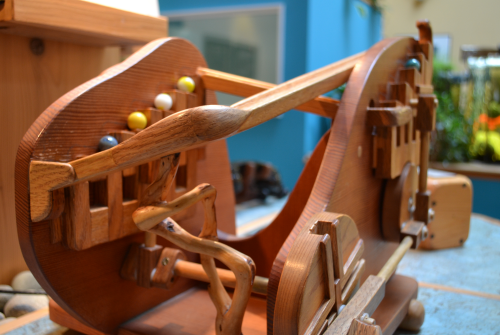By Paul Esau (The Cascade) – Email
Print Edition: January 25, 2012
210 West Holly
Bellingham, Washington
360-647-5614
Hours: Wed-Fri: 12-6, Sat: 10-5,
Sun: 12-4, Mon-Tues: Closed
Admission: Two Beans
I know of few places within an hour’s drive of UFV which are as joyfully unique as MindPort and none that so successfully defy description. The place has been described by staff as a “museum of phenomena,” an institution to “spark your discussion and stimulate your thinking,” and perhaps most truthfully “a work in progress.” Located on a block which includes the SPARK Museum of Electrical Invention and an independent film theatre, it is surrounded by unusual things yet still manages to stand apart.
Physically, MindPort is a jumble of eccentricities and experiments: a machine for making music from waves in one corner and a playable washtub bass in another. Children float pieces of wood down a stream rushing through the reception area, while using stones to divert its current. A university student tunes the dials on a short-wave radio, attempting to retrieve skills his father’s generation would have considered essential, while a woman studies a marble machine hand-carved by one of the directors (it is called Marbellous and its intricacies took fifteen months to build). My first thought upon entering MindPort was that it was much akin to Vancouver’s Science World, yet, while it is composed of a number of exhibits demonstrating artistic and scientific principles, MindPort consistently defies accurate comparison. It seems easier to define it by what it’s not, than by what it is.
First of all, MindPort is not simply a children’s museum. While it is open to visitors of all ages, there are strict rules in place about the ratio of adults to children within each group. Kevin Jones, founding member and current director, explains that the staff have “gone out of our way not to call ourselves a children’s organization…. Children’s museums have a certain tone and they have to make their exhibits bomb-proof, and the more bomb-proof you make an exhibit the less interesting it is.” Children are welcome, yet the exhibits are designed to educate a range of audiences.
MindPort is also non-profit (unofficially), avoids partnerships with government organizations and refuses to conform (to pretty much anything). General admission is $2 per person (compare that to Science World at $23.50) and while Jones admits that MindPort would never break even without private donors, he is adamant that operational freedom is more important than the advantages of seeking official support. This freedom is, according to Jones, one of the integral values of MindPort. They’ll “just keep building stuff, keep amusing ourselves, and see where we go,” he says, “that way it’s an adventure.”
A visit to MindPort is meant to provoke questions, and one of those inevitable questions is how Jones and his staff get the ideas for the exhibits. Jones himself, who has built 30 to 40 exhibits over his 15 years with the organization, admits that it’s hard to nail down a single source. “They come from all kinds of places…” he says. “The wave music exhibit came about because I’ve been attached to boats since I was very young… and I started thinking, well, waves are very rhythmic and what would happen if you took the patterns of water movement and translated them into music? So [the ideas] just come from waking up in the middle of the night with some silly idea. They come by serendipity.”
 Unlike in many similar organizations, Jones makes no attempt to track the popularity of single exhibits, or to remove exhibits which the staff support but don’t experience much traffic. He considers himself to be more of a conductor than a director, and believes that at heart MindPort is a grassroots expression of the joy of curiosity. The “museum” is a way to help people rediscover their environment and consider questions they have perhaps forgotten to ask. “The first exhibit I built,” recalls Jones, “was the one called Interdependence down there by the short-wave radio, and I would say that one person in 100 takes the trouble to really look at that and think about it, but that one person in a 100 is responding to something that maybe they would never see any place else… my attitude has been ‘well, we’ll have a few exhibits out there that aren’t necessarily popular, because there are people that are going to be interested by them, and those people may be exceptional people and exceptional people need to be encouraged.’”
Unlike in many similar organizations, Jones makes no attempt to track the popularity of single exhibits, or to remove exhibits which the staff support but don’t experience much traffic. He considers himself to be more of a conductor than a director, and believes that at heart MindPort is a grassroots expression of the joy of curiosity. The “museum” is a way to help people rediscover their environment and consider questions they have perhaps forgotten to ask. “The first exhibit I built,” recalls Jones, “was the one called Interdependence down there by the short-wave radio, and I would say that one person in 100 takes the trouble to really look at that and think about it, but that one person in a 100 is responding to something that maybe they would never see any place else… my attitude has been ‘well, we’ll have a few exhibits out there that aren’t necessarily popular, because there are people that are going to be interested by them, and those people may be exceptional people and exceptional people need to be encouraged.’”
In my opinion, MindPort is a beautiful example of a true community movement: a group of individuals coming together to visualize their ideas on science and art in a public forum. It’s a great destination for an afternoon south of the border with friends, family or perhaps even a date, although I should warn you that once you ventured past the reception desk, you won’t easily leave. What MindPort really does is ignite the embers of our curiosity, show us how much of our world we still hunger to understand.
About the Director: Kevin Jones
Kevin Jones was one of the three founders of MindPort 15 years ago, and has been part of the organization ever since. He describes himself as being “tremendously curious… about everything, maybe too many things,” and his curiosity has allowed him to accumulate a tremendous number of technical skills. Jones has been self-employed for 35 years, and has worked in carpentry, electric, TV Repair, ceramics, programming, and boat customization. He has sold hydrophones for listening to whales, constructed a universal audio to digital converter (back when it was hard to do), and has spent an unreasonable amount of time formulating the electronics and design for a high-tech espresso machine. Jones, like MindPort itself, has a profoundly unusual story, and I highly recommend checking out his director page on the MindPort website before visiting the “museum.”
Favourite Exhibit: Marble Pump
Oddly enough, the creation I found hardest to walk away from in MindPort was Jones’ Marble Pump. By turning a crank at the bottom, one causes a series of marbles to advance up an interlocking staircase, mirrored by an identical staircase mounted behind it. The nature of the cranking mechanism allows the rotating shaft to produce two speeds of motion, which means that the marbles advances up one staircase at twice the speed of the other. This, of course, encourages the operator to crank harder, slower, and even move marbles in a futile attempt to achieve the human inclination for symmetry.



